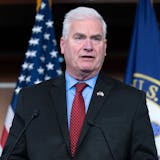Danielle Goerke has heard the well-meaning joke many times. At least you have job security!
Goerke is ready with her standard response.
"I would take one-tenth of the job security to have more resources for my patients," she said. "Even if we trained 10 times more people, we'd still be at a deficit. That's not a fun feeling."
Goerke is "painfully aware" of how unusual she is. She came to the University of Minnesota after medical school to do a residency in adult psychiatry, then completed a fellowship in children and adolescent psychiatry in 2013. She's now an assistant professor of psychiatry specializing in children and teens.
As I reported last Sunday, there are only about 8,300 practicing child psychiatrists in the United States, out of a total of about 41,000 psychiatrists. Many of them are moving toward retirement, while just 5 percent of new medical school students choose psychiatry.
That leaves a growing number of youngsters, particularly in rural areas, vulnerable to falling through the cracks. Rates of depression rise substantially from age 13 to 18, according to the National Institute of Mental Health. Without quick and proper interventions, mental illnesses can follow a child right into adulthood.
While child psychiatric ranks won't be increasing tenfold soon, as Goerke dreams, Minnesota has reason to be optimistic. Aside from model collaborations and mental health training built early into medical school classwork, leaders are taking a rather un-Minnesotan approach:
They're proudly selling psychiatry as a fulfilling, long-term and lucrative profession.

